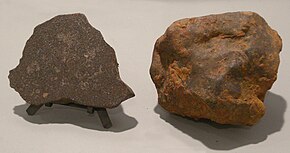Type a search term to find related articles by LIMS subject matter experts gathered from the most trusted and dynamic collaboration tools in the laboratory informatics industry.
| Pultusk | |
|---|---|
 | |
| Type | Chondrite |
| Class | Ordinary chondrite |
| Group | H5 |
| Composition | Olivine and bronzite, kamacite, troilite and chromite also present. |
| Country | Poland |
| Region | Ostrołęka |
| Coordinates | 52°46′N 21°16′E / 52.767°N 21.267°E |
| Observed fall | Yes |
| Fall date | January 30, 1868 |
| TKW | about 8860 kg (about 9.8 tons) |
| Strewn field | Yes |
 Distribution ellipse of Pultusk fall. | |
Pultusk is an H5 ordinary chondrite meteorite which fell on 30 January 1868 in Poland near the town of Pułtusk. The event has been known as the stony meteorite shower with the largest number of pieces yet recorded in history.[1] Made up of rocky debris, it consists of pyroxene or olivine chondrules deployed in massive plagioclase. Kamacite is also reported.
The fall occurred on January 30, 1868, at 7:00 pm near the town of Pułtusk, about 60 kilometres (37 mi) northeast of Warsaw. Thousands of people witnessed a large fireball followed by detonations and a very large shower of small fragments falling on ice, land and houses within an area of about 127 sq km (appx. 78 sq. miles). The estimated number of fragments was 68780.[2][n 1]
The fragments ranged in weight from half a gram to 9.095 kilograms (20.05 lb) (the largest specimen). The overall estimated mass of the meteorites was 8,863 kilograms (19,540 lb). The vast majority of the fragments were small (few grams), known as Pultusk Peas. The Pultusk meteorite is the largest stony meteorite shower ever recorded.[3]
Pultusk is brecciated and contains two varieties of xenoliths embedded in a dark brecciated matrix. It is a veined and brecciated chondrite with abundant xenoliths with various degrees of recrystallisation. Petrologic type 5 xenoliths prevail,[4] so it has been classified as H5: an ordinary chondrite significantly thermally metamorphosed and with the contours of the chondrules frequently difficult to distinguish. The main minerals are olivine and bronzite. Kamacite, troilite and chromite are also present.

The chemical elements and the respective quantity found in the Pultusk meteorite have been described as SiO2 36.44 wt%, TiO2 0.18 wt%, Al2O3 1.88 wt%, Cr2O3 0.37 wt%, FeO 9.48 wt%, MnO 0.25 wt%, MgO 23.75 wt%, CaO 1.82 wt%, Na2O 0.83 wt%, K2O 0.09 wt%, P2O5 0.22 wt%, Fe 16.02 wt%, Ni 1.61 wt%, FeS 5.97 wt%, Fe (metallic) 17.62 wt%, Ni (metallic) 9.13 wt%, Fe as iron sulfide 3.80 wt%, S as iron sulfide 2.17 wt%, total content of iron 27.19 wt%.[5]